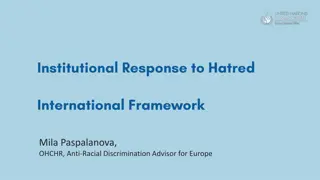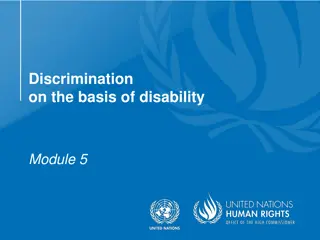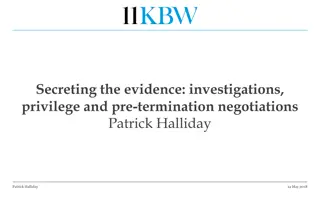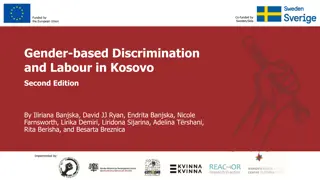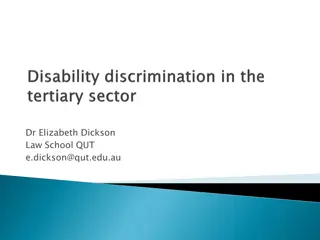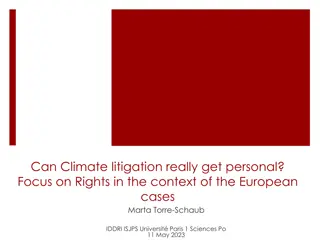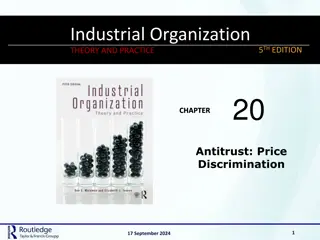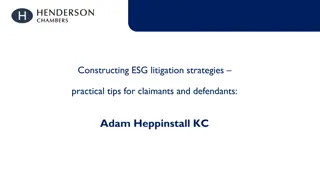Fighting Systemic Discrimination Through Litigation: A Legal Perspective
This content delves into the crucial role of litigation in combatting systemic discrimination, particularly in the context of under-representation of women in male-dominated work environments. It emphasizes the need for multiple strategies, including legal action, to address discriminatory barriers and practices effectively. The definitions of systemic discrimination, examples of cases, and positive features of systemic remedies are explored to provide a comprehensive understanding of the issue.
Download Presentation

Please find below an Image/Link to download the presentation.
The content on the website is provided AS IS for your information and personal use only. It may not be sold, licensed, or shared on other websites without obtaining consent from the author.If you encounter any issues during the download, it is possible that the publisher has removed the file from their server.
You are allowed to download the files provided on this website for personal or commercial use, subject to the condition that they are used lawfully. All files are the property of their respective owners.
The content on the website is provided AS IS for your information and personal use only. It may not be sold, licensed, or shared on other websites without obtaining consent from the author.
E N D
Presentation Transcript
LITIGATING SYSTEMIC DISCRIMINATION LA DISCRIMINATION SYST MIQUE DEVANT LES TRIBUNAUX B atrice Vizkelety, B.A., B.C.L., LL.M.
Introduction WHY LITIGATE SYSTEMIC DISCRIMINATION ? Widespread criticism and scepticism o MULTIPLE STRATEGIES (INCLUDING LITIGATION)REQUIRED TO ELIMINATE DISCRIMINATORY BARRIERS AND PRACTICES
Gaz Mtro Commission des droits de la personne et des droits de la jeunesse et al. c. Gaz m tropolitain inc., 2008 QCTDP 24 (Rivet, J.), conf d for the most part by Quebec Court of Appeal, 2011 QCCA 1201 ( Forget, Rochon, Dufresne, J.C.A.) Under-representation of women in a male-dominated blue collar work positions and segregated environment ; women 5 % of maintenance workers when the available applicant pool was closer to 24 %. Analysis of the hiring system , selection process and tools (if and how various components of the system contributed to under-representation.) Job requirements (incl. indirect discrimination of permit requirement) Interview (purpose unclear, discriminatory questions, experience narrowly construed, unstructured, subjective approach fertile ground for discrimination) Written test (Highly selective leading to low success rate; Element of Bennett Test - found elsewhere to discriminate against women) Practical test (Exemptions for men, discretionary, differential treatment & failure to take into account different physical characteristics of women) Medical examination (at ultimate stage of process after numerous attempts eliminated on the basis of .pregnancy ) Culture of discrimination
Definition of Systemic Discrimination Definition of systemic discrimination (English translation): Hence, the Tribunal believes it is now appropriate to define systemic discrimination as the cumulative effects of disproportionate exclusion resulting from the combined impact of attitudes marked by often unconscious biases and stereotypes, and policies and practices generally adopted without taking into consideration the characteristics of the members of groups contemplated by the prohibition of discrimination. (36) Also, see par. 40, 67
Positive Features DEFINITION OF SYSTEMIC Gaz M tro: Classic case of discrimination in the workplace Also see, Tanisma c. Montr al (Ville de) 2013 QCCS 2479, June 4, 2014 (Peacock, J.) o o OTHER CONTEXTS ? SYSTEMIC REMEDIES Mandatory order to develop and implement a supervised affirmative action programme In Tanisma v. Citiy of Montreal, mandatory order with a systemic component: (City ordered to ensure that all management positions are clearly and publicly posted appropriately for access both internally, and where appropriate externally, to ensure the widest exposure to potential candidates;) o o (Existing employment equity programmes - raise issues of MONITORING and ACCOUNTABILITY )
Potvin no.1 Commission des droits de la personne et des droits de la jeunesse c Commission scolaire des Phares, 2004 CanLII 46172 (QC TDP) Child with Downs Syndrome and moderate to severe intellectual disability whether school board justified in placing child in special education class and not adequately considering integrated education. TDP found discrimination based on disability Commission scolaire des Phares c. Commission des droits de la personne et des droits de la jeunesse, [2006] R.J.Q. 378 (C.A.), conf ing in part TDP decision Court s order (translation): That School Board conduct a individualized assessment to establish his needs as well as his learning and social aptitudes, by adapting the evaluation and classification standards in a manner that would take his disability into account. That Board develop an action plan based on all reasonable forms of accommodation that would allow the child to be integrated in a regular class close to his home; Lastly, that the Board determine on this basis, whether integration is in the child s best interest.
Potvin no. 2- Systemic approach Qu bec (Comm. des droits de la personne et des droits de la jeunesse) c. Phares, Comm. scolaire (No. 2) (2009), CHRR Doc. 09-2834, 2009 QCTDP 19 Continued refusal to integrate Jo l in a regular class bet. 2006 and 2008 Second application based this time - on a systemic approach. Quebec Human Rights Tribunal findings: Practically none of the students with intellectual disabilities were integrated into regular classes especially at the high school level (admittedly, small numbers) Little or no training provided for teachers with respect to integration of students with moderate to severe learning disabilities part of an organizational culture contrary to the Quebec government s policy on Integration (1999). Regular classes organized in a way which did not favour integration. In other words, system favoured placement of students with mental disabilities in separate specialized classes. TDP: It was not so much the interests of the child that determined the placement as the fact that ordinary classes were not organized in a manner that made integration feasible.(509)
Potvin no. 2 - systemic remedies Remedies with systemic components Considering the systemic problems and in addition to individual remedies, the Tribunal ordered the School Board to: Modify its policy on services to students with learning disabilities clearly stating that accommodation in a regular class must be considered first, with necessary accommodation measures and reorganization of adapted services in order to take into account the modifications to its policy. Provide training on principles governing school integration to teachers and other staff members by experts in the field of integrated education. Establish a committee responsible for the implementation of measures leading to the successful integration in regular classes. Reassess Jo l s classification, and that of other students with disabilities without discrimination, based on their needs and best interest. (Orders including deadlines and supervision by Human Rights Commission.)
Potvin no. 2 Court of appeal Phares, Comm. scolaire c. Qu bec (Comm. des droits de la personne et des droits de la jeunesse) (No3) 75 C.H.R.R. D/80, 2012 QCCA 988 C.A.Q. in Potvin no. 2 Dismissed the case finding that the claimants had not shown that the School Board's decision was unreasonable (par.123). Possible explanations: Systemic approach not deemed appropriate ? Analytical framework proposed by CAQ in Potvin no. 1 not a straightjacket (par. 131) - systemic approach based on process replaced by a reasonableness standard . Deferential attitude towards school board (a public body) Court s response to creative corrective measures ordered by first tribunal (par. 192). ideological differences ? Court s apparent reservations about integrated schooling for children with mental disabilities : Enfin, la preuve a r v l que l'int gration en classe ordinaire devient plus difficile mesure que les mati res enseign es deviennent plus abstraites. (par. 178)
Moore Moore v. North Vancouver School Dist. No. 44 (No. 2) (2005), 54 C.H.R.R. D/245, 2005 BCHRT 580 Special services for child with dyslexia denied. Failure to provide the child with access to a meaningful education. The B.C. Human Rights Tribunal examined the two allegations of discrimination, one related to the individual case and the second filed against the government (Ministry of Education) on the grounds of under-funding and significant budget cuts. Cuts led to the closure of a centre (DIAGNOSTIC CENTRE (DC1)) which provided intensive services and individualized assistance to students with severe learning disabilities to help develop reading skills. Goal of a systemic analysis: [840] the goal of a systemic analysis in this case is to review all of the evidence about the education system to examine the way in which it operates, as a system, to ensure that it is accessible to SLD students in a meaningful way. If that evidence discloses that there are systemic barriers, through Ministry policies or actions, that do not facilitate access, then a finding of systemic discrimination should follow.
Moore - findings Summary of findings The District discriminated against Jeffrey inter alia by : not following their own recommendation that he attend the DC1 and not ensuring that, following the DC1 closure, other sufficiently intense and effective interventions were in place to replace it. (903) The District also discriminated against all of its SLD students by: closing the DC1 without ensuring that other sufficiently intensive interventions were available thereafter; not ensuring that there was a range of services for SLD students adequate to their needs; and disproportionately cutting core services for SLD students. The Ministry discriminated inter alia by : establishing and maintaining a cap on funding of a relevant programme and thus underfunding the actual incidence of the students subject to it, including the SLD category; underfunding the District through not implementing the recommendations of a study until after the District experienced a financial crisis that resulted in significant cuts to the services provided to SLD students; and by focussing its monitoring only on spending and fiscal concerns and failing to ensure that early intervention and a range of services for SLD students was mandatory. (870)
Moore & Systemic Remedies systemic remedies and orders (In addition to individual compensation) THAT the District, within one year of this decision: (i) establish mechanisms for determining that its delivery of services to SLD students are appropriate and meet the stated goals of the School Act, the Special Needs Student Order, and the 1995 Manual; (ii) ensure that it has in place an early intervention program so that SLD students can be identified early and appropriate intensive remediation services provided; and (iii) ensure that it has in place a range of services to meet the needs of its SLD students. THAT the Ministry, within one year of this decision: (i) make available funding for SLD students at actual incidence levels; (ii) establish mechanisms for determining that the support and accommodation services provided to SLD students in the Province are appropriate and meet the stated goals of the School Act and the Special Needs Student Order; (iii) ensure that all districts have in place early intervention programs so that SLD students can be identified early and appropriate intensive remediation services provided; and (iv) ensure that all school districts have in place a range of services to meet the needs of SLD students. The Tribunal will remain seized of this matter to ensure that its remedial orders are appropriately implemented. Par. 1024-1026
Moore SCC (Abella, j.) Moore v. British Columbia (Education), 2012 SCC 61 Tribunal s conclusions regarding discrimination by the District School Board confirmed but those against the Ministry dismissed Evidence about the provincial funding regime too remote to establish discrimination against claimant (par. 65). Prima facie case of discrimination made out (that the remediation was far from adequate to give Jeffrey the education to which he was entitled, fully supported by the evidence.) (par. 41 and 48) But, Court also notes the following elements concerning the School District : Absence of needs-based analysis before closure of centre (43) Failure to consult experts prior to closure (44) Failure to have plan in place for upcoming school year addressing the needs of SLD students in the absence of the centre (44) District s motivation in closing centre exclusively financial but failure to consider financial alternatives undermines the district s argument that it had no economic choice : to decide that it had no other choice, it had at least to consider what those other choices were. (46 and 52)
Moore on (systemic) remedies REMEDIES While a remedy for an individual complainant (confirmed) can have a systemic impact, the remedy must flow from the claim: But the remedy must flow from the claim. In this case, the claim was made on behalf of Jeffrey, and the evidence giving concrete support to the claim all centred on him. While the Tribunal was certainly entitled to consider systemic evidence in order to determine whether Jeffrey had suffered discrimination, it was unnecessary for it to hold an extensive inquiry into the precise format of the provincial funding mechanism or the entire provincial administration of special education in order to determine whether Jeffrey was discriminated against. The Tribunal, with great respect, is an adjudicator of the particular claim that is before it, not a Royal Commission. (64) Order regarding implementation of mechanisms essentially an order to comply with Human Rights Code ---to that extent redundant (65) Finally, no need for tribunal to remain seized of the matter - student has since graduated from high school and it goes without saying that if the District is to avoid similar claims [ ] it will ensure that it provides a range of services for special needs students in accordance with the school act and related policies. (66)
Questions raised by Moore QUESTIONS: Is such an order redundant ? Can we continue to assume that compliance will occur without specific measures to avoid the recurrence of discrimination; without specific measures to counteract past practices, an organizational culture, attitudes, conscious or unconscious stereotypes (as in Bombardier), etc. that fail to take into account the rights and needs of minorities and other protected groups ? Is the purpose merely to avoid similar claims or to ensure future compliance ?




